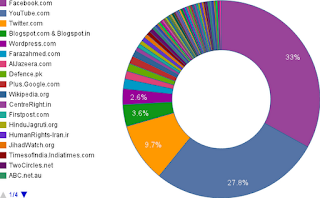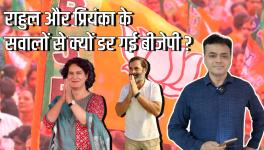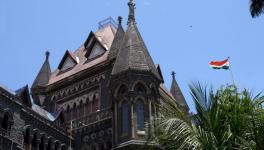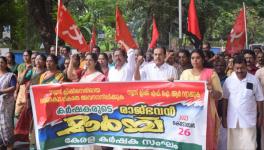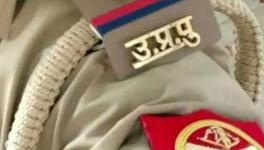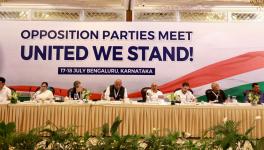Analysing Latest List of Blocked Sites (Communalism & Rioting Edition)
Pranesh Prakash does preliminary analysis on a leaked list of the websites blocked from August 18, 2012 till August 21, 2012 by the Indian government.
Note: This post will be updated as more analysis is done. Last update: 23:59 on August 22, 2012. This is being shared under a Creative Commons Attribution-NonCommercial licence]
How many items have been blocked?
There are a total of 309 specific items (those being URLs, Twitter accounts, img tags, blog posts, blogs, and a handful of websites) that have been blocked. This number is meaningless at one level, given that it doesn't differentiate between the blocking of an entire website (with dozens or hundreds of web pages) from the blocking of a single webpage. However, given that very few websites have been blocked at the domain-level, that number is still reasonably useful.
Please also note, we currently only have information related to what telecom companies and Internet Service Providers (ISPs) were asked to block till August 21, 2012. We do not have information on what individual web services have been asked to remove. That might take the total count much higher.
Why have these been blocked?
As far as I could determine, all of the blocked items have content (mostly videos and images have been targeted, but also some writings) that are related to communal issues and rioting. (Please note: I am not calling the content itself "communal" or "incitement to rioting", just that the content relates to communal issues and rioting.) This has been done in the context of the recent riots in Assam, Mumbai, UP, and the mass movement of people from Bangalore.
There were reports of parody Twitter accounts having been blocked. Preliminary analysis on the basis of available data show that parody Twitter accounts and satire sites have not been targetted solely for being satirical. For instance, very popular parody Twitter accounts, such as @DrYumYumSingh are not on any of the four orders circulated by the Department of Telecom. (I have no information on whether such parody accounts are being taken up directly with Twitter or not: just that they aren't being blocked at the ISP-level. Media reports indicate six accounts have been taken up with Twitter for being similar to the Prime Minister's Office's account.)
Are the blocks legitimate?
The goodness of the government's intentions seem, quite clearly in my estimation, to be unquestionable. Yet, even with the best intentions, there might be procedural illegalities and over-censorship.
There are circumstances in which freedom of speech and expression may legitimately be limited. The circumstances that existed in Bangalore could justifiably result in legitimate limitations on freedom of speech. For instance, I believe that temporary curbs — such as temporarily limiting SMSes & MMSes to a maximum of five each fifteen minutes for a period of two days — would have been helpful.
However it is unclear whether the government has exercised its powers responsibly in this circumstance. The blocking of many of the items on that list are legally questionable and morally indefensible, even while a some of the items ought, in my estimation, to be removed.
If the government has blocked these sites under s.69A of the Information Technology Act ("Power to Issue Directions for Blocking for Public Access of Any Information through any Computer Resource"), the persons and intermediaries hosting the content should have been notified provided 48 hours to respond (under Rule 8 of the Information Technology (Procedure and Safeguards for Blocking for Access of Information by Public) Rules 2009). Even if the emergency provision (Rule 9) was used, the block issued on August 18, 2012, should have been introduced before the "Committee for Examination of Request" by August 20, 2012 (i.e., within 48 hours), and that committee should have notified the persons and intermediaries hosting the content.
Importantly, even though many of the items on that list are repugnant and do deserve (in my opinion) to be removed, ordering ISPs to block them is largely ineffectual. The people and companies hosting the material should have been asked to remove it, instead of ordering Internet service providers (ISPs) to block them. All larger sites have clear content removal policies, and encouraging communal tensions and hate speech generally wouldn't be tolerated. That this can be done without resort to the dreadful Intermediary Guidelines Rules (which were passed last year) shows that those Rules are unnecessary. It is our belief that those Rules are also unconstitutional.
Are there any egregious mistakes?
Yes, there are numerous such examples of egregious mistakes.
-
Most importantly, some even people and posts debunking rumours have been blocked.
-
Some of the Twitter accounts are of prominent people who write for the mainstream media, and who have written similar content offline. If their online content is being complained about, their offline content should be complained about too.
-
Quite a number of the links include articles published and reports broadcast in the mainstream media (including a Times Now report, a Telegraph picture gallery, etc.), and in print, making the blocks suspect. Only the online content seems to have been targeted for censorship.
There are numerous mistakes and inconsistencies that make blocking pointless and ineffectual.
-
Some of the items are not even web addresses (e.g., a few HTML img tags were included).
-
Some of the items they have tried to block do not even exist (e.g., one of the Wikipedia URLs).
-
An entire domain was blocked on Sunday, and a single post on that domain was blocked on Monday.
-
For some Facebook pages, the secure version (https://facebook.com/...) is listed, for others the non-secure version (http://facebook.com/...) is listed.
-
For some YouTube videos, the 'base' URL of YouTube videos is blocked, but for other the URL with various parameters (like the "&related=" parameter) is blocked. That means that even nominally 'blocked' videos will be freely accessible.
All in all, it is clear that the list was not compiled with sufficient care.
Despite a clear warning by the DIT that "above URLs only" should be blocked, and not "the main websites like www.facebook.com, www.youtube.com, www.twitter.com, etc.", it has been seen that some ISPs (like Airtel) have gone overboard in their blocking.
Why haven't you put up the whole list?
Given the sensitivity of the issue, we felt it would be premature to share the whole list. However, we strongly believe that transparency should be an integral part of all censorship. Hence, this analysis is an attempt to provide some much-needed transparency. We intend to make the entire list public soon, though. (Given how porous such information is, it is likely that someone else will procure the list, and release it sooner than us.)
Why can I still access many items that are supposed to be blocked?
One must keep in mind that fresh orders have been issued on a day-by-day basis, that there are numerous mistakes in the list making it difficult to apply (some of these mistakes have been mentioned above), and the fact that that this order has to be implemented by hundreds of ISPs.
Your ISP probably has not have got around to enforcing the blocks yet. At the time of this writing, most ISPs don't seem to be blocking yet. This analysis is based on the orders sent around to ISPs, and not on the basis of actual testing of how many of these have actually been blocked by Airtel, BSNL, Tata, etc.
Additionally, if you are using Twitter through a client (on your desktop, mobile, etc.) instead of the web interface, you will not notice any of the Twitter-related blocks.
So you are fine with censorship?
No. I believe that in some cases, the government has the legal authority to censor. Yet, exercising that legal authority is usually not productive, and in fact there are other, better ways of limiting the harms caused by speech and information than censorship. Limiting speech might even prove harmful in situations like these, if it ends up restricting people's ability to debunk false rumours. In a separate blog post (to be put up soon), I am examining how all of the government's responses have been flawed both legally and from the perspective of achieving the desired end.
So what should the government have done?
Given that the majority of the information it is targeting is on Facebook, Youtube, and Twitter, the government could have chosen to fight alongside those services to get content removed expeditiously, rather than fight against them. (There are some indications that the government might be working with these services, but it certainly isn't doing enough.)
For instance, it could have asked all of them to expedite their complaints mechanism for a few days, by ensuring that the complaints mechanism is run 24x7 and that they respond quickly to any complaint submitted about communal incitement, spreading of panic, etc. This does not need the passing of an order under any law, but requires good public relations skills and a desire not to treat internet services as enemies. The government could have encouraged regular users to flag false rumours and hate speech on these sites. On such occasions, social networking sites should step up and provide all lawful assistance that the government may require. They should also be more communicative in terms of the help they are providing to the government to curtail panic-inducing rumours and hate speech. (Such measures should largely be reactive, not proactive, to ensure legitimate speech doesn't get curtailed.)
The best antidote for the rumours that spread far and wide and caused a mass movement of people from Bangalore to the North-Eastern states would have been clear debunking of those rumours. Mass outreach to people in the North-East (very often the worried parents) and in Bangalore using SMSes and social media, debunking the very specific allegations and rumours that were floating around, would have been welcome. However, almost no government officials actually used social media platforms to reach out to people to debunk false information and reassure them. Even a Canadian interning in our organization got a reassuring SMS from the Canadian government.
It is indeed a pity that the government notified a social media engagement policy today, when the need for it was so very apparent all of the past week.
And what of all this talk of cybersecurity failure and cyber-wars?
Cybersecurity is indeed a cause of concern for India, but only charlatans and the ignorant would make any connection between India's cybersecurity and recent events. The role of Pakistan deserves a few words. Not many Pakistani websites / webpages have been blocked by the Indian government. Two of the Pakistani webpages that have been blocked are actually pages that debunk the fake images that have been doing the rounds in Pakistan for at least the past month. Even Indian websites like Kafila have noted these fake images long ago, and Ayesha Siddiqa wrote about this on August 5, 2012, and Yousuf Saeed wrote about it on August 13, 2012. Even while material that may have been uploaded from Pakistan, it seems highly unlikely they were targeted at an Indian audience, rather than a Pakistani or global one.
|
Domain |
Total Number of Entries |
Tuesday, August 21, 2012 |
Monday, August 20, 2012 |
Sunday, August 19, 2012 |
Saturday, August 18, 2012 |
|
ABC.net.au |
1 |
|
|
|
1 |
|
AlJazeera.com |
4 |
|
4 |
|
|
|
AllVoices.com |
1 |
|
|
|
1 |
|
WN.com |
1 |
|
|
|
1 |
|
AtjehCyber.net |
1 |
|
|
|
1 |
|
BDCBurma.org |
1 |
1 |
|
|
|
|
Bhaskar.com |
1 |
|
|
1 |
|
|
Blogspot.com |
4 |
|
|
3 |
1 |
|
Blogspot.in |
7 |
1 |
3 |
|
3 |
|
Catholic.org |
1 |
|
|
1 |
|
|
CentreRight.in |
2 |
2 |
|
|
|
|
ColumnPK.com |
1 |
|
|
1 |
|
|
Defence.pk |
4 |
|
2 |
1 |
1 |
|
EthioMuslimsMedia.com |
1 |
|
|
|
1 |
|
Facebook.com (HTTP) |
75 |
36 |
7 |
18 |
14 |
|
Facebook.com (HTTPS) |
27 |
|
3 |
23 |
1 |
|
Farazahmed.com |
5 |
1 |
|
|
4 |
|
Firstpost.com |
2 |
|
1 |
1 |
|
|
HaindavaKerelam.com |
1 |
|
|
1 |
|
|
HiddenHarmonies.org |
1 |
|
1 |
|
|
|
HinduJagruti.org |
2 |
|
1 |
1 |
|
|
Hotklix.com |
1 |
|
|
1 |
|
|
HumanRights-Iran.ir |
2 |
|
|
|
2 |
|
Intichat.com |
1 |
1 |
|
|
|
|
Irrawady.org |
1 |
|
|
1 |
|
|
IslamabadTimesOnline.com |
1 |
|
|
|
1 |
|
Issuu.com |
1 |
|
|
|
1 |
|
JafriaNews.com |
1 |
|
|
|
1 |
|
JihadWatch.org |
2 |
|
2 |
|
|
|
KavkazCenter |
1 |
|
|
1 |
|
|
MwmJawan.com |
1 |
|
|
|
1 |
|
My.Opera.com |
1 |
1 |
|
|
|
|
Njuice.com |
1 |
|
1 |
|
|
|
OnIslam.net |
1 |
|
|
|
1 |
|
PakAlertPress.com |
1 |
1 |
|
|
|
|
Plus.Google.com |
4 |
|
|
|
4 |
|
Reddit.com |
1 |
|
1 |
|
|
|
Rina.in |
1 |
|
|
|
1 |
|
SandeepWeb.com |
1 |
|
1 |
|
|
|
SEAYouthSaySo.com |
1 |
|
|
|
1 |
|
Sheikyermami.com |
1 |
|
|
|
1 |
|
StormFront.org |
1 |
|
|
|
1 |
|
Telegraph.co.uk |
1 |
|
|
|
1 |
|
TheDailyNewsEgypt.com |
1 |
|
|
|
1 |
|
TheFaultLines.com |
1 |
|
|
|
1 |
|
ThePetitionSite.com |
1 |
1 |
|
|
|
|
TheUnity.org |
1 |
|
|
|
1 |
|
TimesofIndia.Indiatimes.com |
2 |
|
2 |
|
|
|
TimesOfUmmah.com |
1 |
|
|
|
1 |
|
Tribune.com.pk |
1 |
1 |
|
|
|
|
Twitter.com (HTTP) |
1 |
|
|
1 |
|
|
Twitter.com (HTTPS) |
11 |
|
|
1 |
10 |
|
Twitter account |
18 |
|
16 |
2 |
|
|
TwoCircles.net |
2 |
|
|
2 |
|
|
Typepad.com |
1 |
|
1 |
|
|
|
Vidiov.info |
1 |
|
1 |
|
|
|
Wikipedia.org |
3 |
|
|
3 |
|
|
Wordpress.com |
8 |
1 |
3 |
2 |
2 |
|
YouTube.com |
85 |
18 |
39 |
14 |
14 |
|
YouTu.be |
1 |
|
|
1 |
|
|
|
|
|
|
|
|
|
Totals |
309 |
65 |
89 |
80 |
75 |
This was cross-posted in Outlook on August 23, 2012. See http://bit.ly/PZN75N
Get the latest reports & analysis with people's perspective on Protests, movements & deep analytical videos, discussions of the current affairs in your Telegram app. Subscribe to NewsClick's Telegram channel & get Real-Time updates on stories, as they get published on our website.









